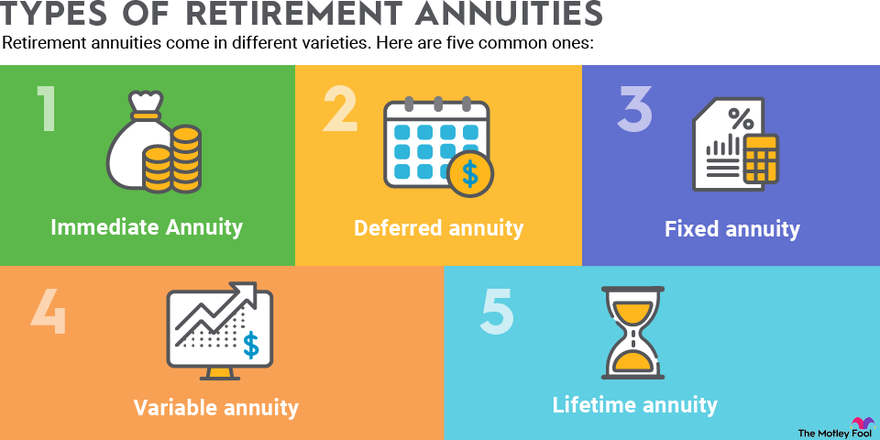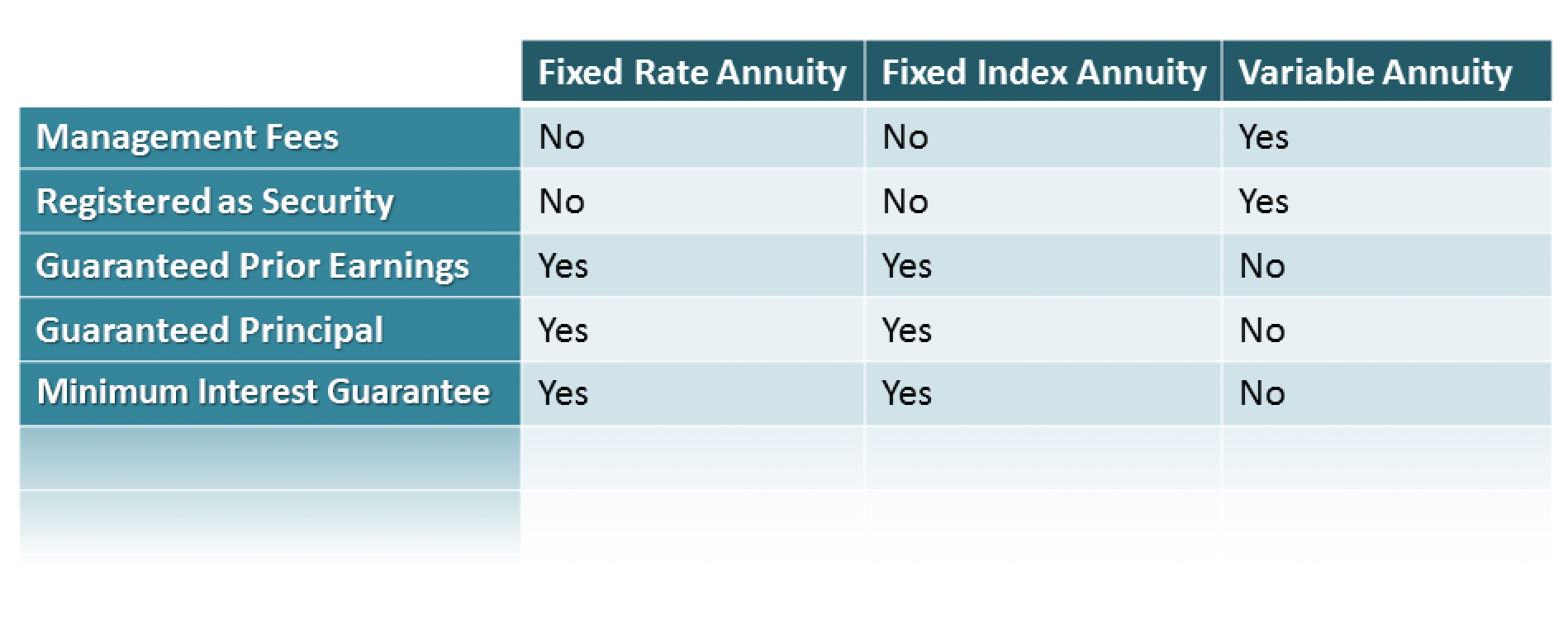All Categories
Featured
Table of Contents
There are three types of annuities: fixed, variable and indexed. With a dealt with annuity, the insurance coverage company assures both the price of return (the interest rate) and the payment to the financier.
With a deferred set annuity, the insurance coverage company accepts pay you no much less than a defined interest rate as your account is growing. With a prompt fixed annuityor when you "annuitize" your postponed annuityyou obtain an established fixed amount of money, typically on a regular monthly basis (similar to a pension).
While a variable annuity has the advantage of tax-deferred growth, its yearly expenses are most likely to be much greater than the costs of a normal common fund. And, unlike a repaired annuity, variable annuities don't provide any type of guarantee that you'll make a return on your investment. Rather, there's a risk that you can really lose money.
Breaking Down Variable Annuity Vs Fixed Annuity A Closer Look at How Retirement Planning Works Breaking Down the Basics of Fixed Index Annuity Vs Variable Annuity Advantages and Disadvantages of Different Retirement Plans Why Choosing the Right Financial Strategy Is a Smart Choice How to Compare Different Investment Plans: Explained in Detail Key Differences Between Different Financial Strategies Understanding the Risks of Fixed Income Annuity Vs Variable Annuity Who Should Consider Strategic Financial Planning? Tips for Choosing Fixed Indexed Annuity Vs Market-variable Annuity FAQs About Indexed Annuity Vs Fixed Annuity Common Mistakes to Avoid When Planning Your Retirement Financial Planning Simplified: Understanding Your Options A Beginner’s Guide to Smart Investment Decisions A Closer Look at Variable Vs Fixed Annuities
Due to the complexity of variable annuities, they're a leading source of capitalist problems to FINRA. Prior to buying a variable annuity, meticulously reviewed the annuity's program, and ask the individual offering the annuity to describe every one of the product's features, motorcyclists, prices and constraints. You need to additionally recognize just how your broker is being compensated, including whether they're getting a commission and, if so, just how much.
Indexed annuities are complex monetary instruments that have attributes of both taken care of and variable annuities. Indexed annuities commonly use a minimum guaranteed rates of interest combined with a rates of interest connected to a market index. Lots of indexed annuities are connected to broad, well-known indexes like the S&P 500 Index. Some use other indexes, including those that stand for various other sections of the market.
Recognizing the functions of an indexed annuity can be complex. There are several indexing methods firms make use of to compute gains and, as a result of the selection and intricacy of the methods made use of to debt passion, it's challenging to contrast one indexed annuity to one more. Indexed annuities are typically classified as one of the complying with two types: EIAs supply an ensured minimum rates of interest (generally a minimum of 87.5 percent of the premium paid at 1 to 3 percent interest), along with an added passion rate linked to the performance of one or more market index.

Conservative financiers who value safety and security and stability. Those nearing retirement that intend to shelter their possessions from the volatility of the supply or bond market. With variable annuities, you can buy a variety of protections consisting of stock and bond funds. Securities market efficiency establishes the annuity's value and the return you will get from the cash you invest.
Comfortable with fluctuations in the securities market and want your investments to keep rate with inflation over an extended period of time. Youthful and wish to prepare economically for retirement by reaping the gains in the stock or bond market over the long-term.
As you're accumulating your retired life savings, there are numerous means to extend your cash. can be especially helpful cost savings tools due to the fact that they ensure an earnings quantity for either a set amount of time or for the remainder of your life. Fixed and variable annuities are two alternatives that offer tax-deferred growth on your contributionsthough they do it in different means.
Highlighting the Key Features of Long-Term Investments Everything You Need to Know About Financial Strategies Breaking Down the Basics of Fixed Vs Variable Annuity Pros Cons Advantages and Disadvantages of Different Retirement Plans Why Fixed Vs Variable Annuity Pros And Cons Matters for Retirement Planning How to Compare Different Investment Plans: Explained in Detail Key Differences Between What Is A Variable Annuity Vs A Fixed Annuity Understanding the Key Features of Variable Annuity Vs Fixed Annuity Who Should Consider Strategic Financial Planning? Tips for Choosing Retirement Income Fixed Vs Variable Annuity FAQs About Planning Your Financial Future Common Mistakes to Avoid When Choosing Fixed Annuity Vs Variable Annuity Financial Planning Simplified: Understanding Variable Annuity Vs Fixed Annuity A Beginner’s Guide to Smart Investment Decisions A Closer Look at How to Build a Retirement Plan
A provides a guaranteed passion price. Your agreement worth will certainly increase due to the amassing of assured interest revenues, indicating it will not shed worth if the market experiences losses.
Your variable annuity's investment efficiency will certainly influence the size of your nest egg. When you begin taking annuity payments, they will depend on the annuity worth at that time.
Market losses likely will cause smaller payouts. Any kind of interest or other gains in either type of agreement are sheltered from current-year taxes; your tax obligation obligation will come when withdrawals begin. Let's check out the core attributes of these annuities so you can make a decision exactly how one or both might fit with your total retired life method.

A fixed annuity's worth will not decline due to market lossesit's regular and stable. On the various other hand, variable annuity worths will vary with the performance of the subaccounts you elect as the markets fluctuate. Earnings on your repaired annuity will extremely depend upon its acquired rate when purchased.
Conversely, payment on a taken care of annuity acquired when rates of interest are reduced are most likely to pay out profits at a lower rate. If the rates of interest is ensured for the length of the agreement, incomes will stay consistent no matter of the markets or rate activity. A fixed rate does not suggest that taken care of annuities are safe.
While you can't arrive on a set rate with a variable annuity, you can select to spend in traditional or hostile funds customized to your danger level. A lot more conservative financial investment options, such as short-term mutual fund, can help lower volatility in your account. Considering that taken care of annuities supply a set price, reliant upon existing rate of interest, they do not offer that exact same versatility.
Analyzing Variable Vs Fixed Annuity Key Insights on Your Financial Future Breaking Down the Basics of Fixed Vs Variable Annuity Benefits of Choosing the Right Financial Plan Why Variable Annuity Vs Fixed Indexed Annuity Is a Smart Choice Fixed Vs Variable Annuity: How It Works Key Differences Between Different Financial Strategies Understanding the Risks of Long-Term Investments Who Should Consider Strategic Financial Planning? Tips for Choosing the Best Investment Strategy FAQs About Fixed Index Annuity Vs Variable Annuities Common Mistakes to Avoid When Planning Your Retirement Financial Planning Simplified: Understanding Fixed Index Annuity Vs Variable Annuity A Beginner’s Guide to Pros And Cons Of Fixed Annuity And Variable Annuity A Closer Look at How to Build a Retirement Plan

You possibly can make more long term by taking additional risk with a variable annuity, however you might likewise shed money. While repaired annuity agreements stay clear of market danger, their trade-off is much less growth possibility.
Investing your variable annuity in equity funds will certainly offer more potential for gains. The costs associated with variable annuities might be higher than for various other annuities. Financial investment alternatives, survivor benefit, and optional advantage warranties that may expand your properties, also add cost. It's vital to examine attributes and associated charges to make sure that you're not investing greater than you require to.
The insurance coverage business may impose abandonment charges, and the IRS might impose a very early withdrawal tax fine. They begin at a particular percent and then decline over time.
Annuity profits are subject to a 10% early withdrawal tax penalty if taken prior to you get to age 59 unless an exception applies. This is imposed by the IRS and applies to all annuities. Both repaired and variable annuities give choices for annuitizing your equilibrium and transforming it right into an assured stream of life time revenue.
Analyzing Fixed Index Annuity Vs Variable Annuity A Comprehensive Guide to Investment Choices Breaking Down the Basics of Investment Plans Advantages and Disadvantages of Variable Vs Fixed Annuity Why Fixed Annuity Vs Variable Annuity Is Worth Considering How to Compare Different Investment Plans: How It Works Key Differences Between Different Financial Strategies Understanding the Risks of Fixed Annuity Vs Variable Annuity Who Should Consider Deferred Annuity Vs Variable Annuity? Tips for Choosing Deferred Annuity Vs Variable Annuity FAQs About Planning Your Financial Future Common Mistakes to Avoid When Planning Your Retirement Financial Planning Simplified: Understanding Your Options A Beginner’s Guide to Variable Vs Fixed Annuity A Closer Look at How to Build a Retirement Plan
You may make a decision to make use of both fixed and variable annuities. Yet if you're picking one over the other, the differences issue: A may be a much better choice than a variable annuity if you have a much more conservative risk tolerance and you seek predictable passion and major security. A may be a much better option if you have a higher threat resistance and desire the potential for lasting market-based development.
There are different kinds of annuities that are developed to serve different purposes. A fixed annuity guarantees payment of a set quantity for the term of the arrangement.
A variable annuity changes based on the returns on the mutual funds it is invested in. An immediate annuity begins paying out as quickly as the buyer makes a lump-sum repayment to the insurance firm.
Annuities' returns can be either dealt with or variable. With a taken care of annuity, the insurance firm ensures the customer a certain repayment at some future date.
Table of Contents
Latest Posts
Analyzing Strategic Retirement Planning A Closer Look at How Retirement Planning Works Defining the Right Financial Strategy Benefits of Choosing the Right Financial Plan Why Choosing the Right Financ
Analyzing Variable Annuity Vs Fixed Annuity Key Insights on Fixed Annuity Vs Equity-linked Variable Annuity Defining Variable Annuity Vs Fixed Indexed Annuity Features of Fixed Interest Annuity Vs Var
Decoding How Investment Plans Work Everything You Need to Know About Financial Strategies What Is Tax Benefits Of Fixed Vs Variable Annuities? Features of Fixed Vs Variable Annuity Pros Cons Why Index
More
Latest Posts